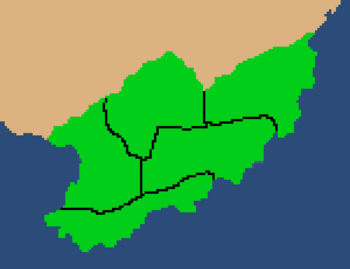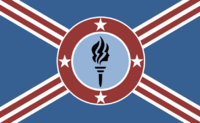Horikoru
The Constitutional Monarchies of Horikoru The Nation of Horikoru | |
|---|---|
| Motto: Through unity comes success | |
| Anthem: High up in the trees | |
 | |
| Location | Southern Abos |
| Capital | Kiroto |
| Largest city | Capital |
| Official languages | Japanese |
| Recognised national languages | Japanese |
| Demonym(s) | Horikan |
| Government | Constitutional Monarchy |
• King | Ikachi Faiwaru |
• Prime Minister | Yuto Matsoki |
| Legislature | Kage Council |
| Tribal Unification | |
• Shogun Unification Day: December 8th, 1675 | Kage Pact: July 5th 1888 |
| Population | |
• 2020 estimate | 13 Million |
| GDP (nominal) | estimate |
• Total | 533 Billion |
• Per capita | 41,000 |
| HDI | .73 high |
| Currency | Yen |
| Date format | dd-mm-yyyy |
| Driving side | left |
| Calling code | (343) |
The Constitutional Monarchies of Horikoru, more commonly known as Horikoru, is an small, humble nation comprised of 5 unified kingdoms on the southern tip of Abos. Huvakia is notable for its booming autmotive industry and untouched nature. Horikoru is known to be rather removed from international politics and tend to focus on more internal affairs.
The Horikoruan economy, worth 533 billion Dollars a year, is broadly diversified and led by the Automobile Manufacturing industry, with major contributions from Hemp products, Agricultural Exports, and Textiles. State-owned companies are somewhat common. Historically, crime was totally unknown, however a recent resurgence in crime has been noticed all around the nation. Horikoru's national animal is the Fox, which enjoys a prosperous life in the nations many forests, deserts, mountains, and grasslands.
In ancient times the lands that would become Horikoru consisted of five different kingdoms, each of which continuously fought with one another for centuries. Eventually as the kingdoms grew tired of fighting and threats from other nations and raiders, the five kingdoms united under the Shogunate Unification. The unification was more like a loose alliance than an actual unification. The Kingdoms had no support from one another unless it was militarily. Under the Shogunate Horikoru saw unrivaled expansion to the north, once bordering what is now Huvakia. However as infighting from the kingdom leaders grew, and the threats from beyond the border grew stronger, the five kingdoms were unable to hold their newly gained territory and eventually were pushed back to their original (current) border. With this embarrassing defeat, the Shogunate dissolved and the five kingdoms unified as one nation governed by a king (also known as Takaikage).
History
In early history the five kingdoms of Horikoru fought among one another, with short lasting alliances, city razing and sieges all being common occurrences. The famed Shinobi (ninja) and Samurai were born during this time. For a large chunk of early Horikan history, the five kingdoms fought for control of smalls claims of land, all to further the kingdoms influence and military might. WIP
Geography
Horikoru is known for its extreme diversity when it comes to climates. Historically, each kingdom was formed around a specific climate or biome. From lush forests to towering mountain ranges, Horikoru has it all. Tourism is a vital part of the Horikan economy. WIP
Climate
Environment
Politics and Government
Military
Horikoru has a deep history of Shinobi. Highly skilled soldiers for hire to preform tasks that the government would rather keep secret. This tradition continues into the modern day, with private security being a fairly large industry in the economy. Due to this fact the Horikan military has remained relatively small and is mainly reserves and national guard that assist the general population when called upon.
Foreign Relations
Economy
The Horikan economy does fairly well for itself. ____ and _____ are its top trading partners. Over the last five years, automobiles have been Horikoru's top export, surpassing textiles in 2015
Energy
Infrastructure
Transport
The main form of transportation in Hoikoru is the automobile, which operate on a network of 1.12 million miles of public roads.

